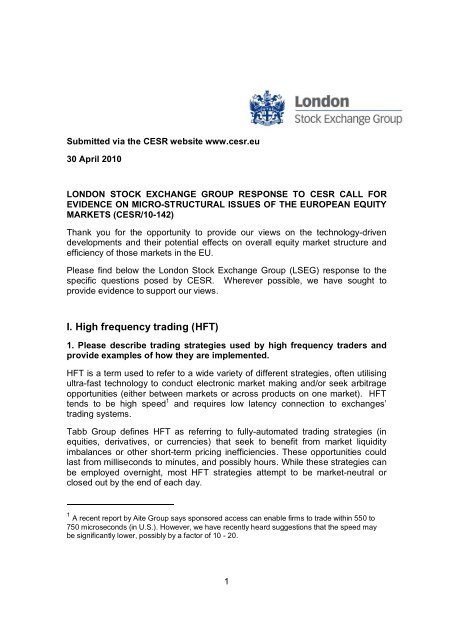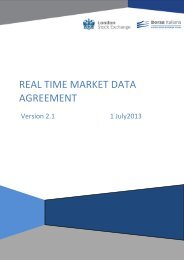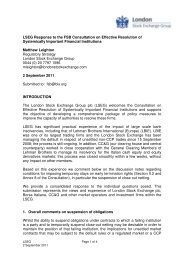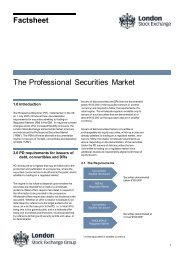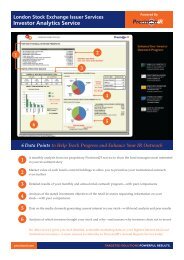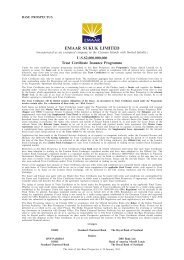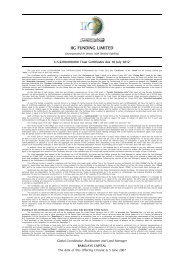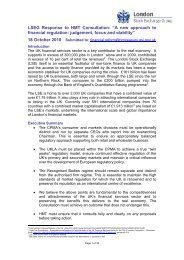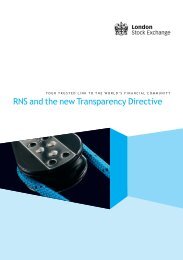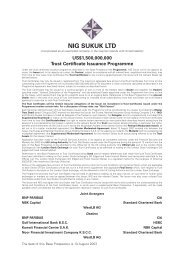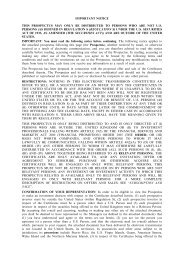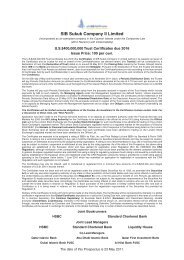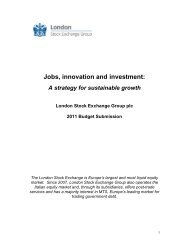I. High frequency trading (HFT) - London Stock Exchange
I. High frequency trading (HFT) - London Stock Exchange
I. High frequency trading (HFT) - London Stock Exchange
You also want an ePaper? Increase the reach of your titles
YUMPU automatically turns print PDFs into web optimized ePapers that Google loves.
Submitted via the CESR website www.cesr.eu<br />
30 April 2010<br />
LONDON STOCK EXCHANGE GROUP RESPONSE TO CESR CALL FOR<br />
EVIDENCE ON MICRO-STRUCTURAL ISSUES OF THE EUROPEAN EQUITY<br />
MARKETS (CESR/10-142)<br />
Thank you for the opportunity to provide our views on the technology-driven<br />
developments and their potential effects on overall equity market structure and<br />
efficiency of those markets in the EU.<br />
Please find below the <strong>London</strong> <strong>Stock</strong> <strong>Exchange</strong> Group (LSEG) response to the<br />
specific questions posed by CESR. Wherever possible, we have sought to<br />
provide evidence to support our views.<br />
I. <strong>High</strong> <strong>frequency</strong> <strong>trading</strong> (<strong>HFT</strong>)<br />
1. Please describe <strong>trading</strong> strategies used by high <strong>frequency</strong> traders and<br />
provide examples of how they are implemented.<br />
<strong>HFT</strong> is a term used to refer to a wide variety of different strategies, often utilising<br />
ultra-fast technology to conduct electronic market making and/or seek arbitrage<br />
opportunities (either between markets or across products on one market). <strong>HFT</strong><br />
tends to be high speed 1 and requires low latency connection to exchanges’<br />
<strong>trading</strong> systems.<br />
Tabb Group defines <strong>HFT</strong> as referring to fully-automated <strong>trading</strong> strategies (in<br />
equities, derivatives, or currencies) that seek to benefit from market liquidity<br />
imbalances or other short-term pricing inefficiencies. These opportunities could<br />
last from milliseconds to minutes, and possibly hours. While these strategies can<br />
be employed overnight, most <strong>HFT</strong> strategies attempt to be market-neutral or<br />
closed out by the end of each day.<br />
1 A recent report by Aite Group says sponsored access can enable firms to trade within 550 to<br />
750 microseconds (in U.S.). However, we have recently heard suggestions that the speed may<br />
be significantly lower, possibly by a factor of 10 - 20.<br />
1
There is no consensus as to how frequent and fast the order flow must be to<br />
qualify as <strong>HFT</strong>. Most <strong>HFT</strong> strategies employ algorithms to generate <strong>trading</strong><br />
signals and manage orders, but not all algorithmic <strong>trading</strong> is high-<strong>frequency</strong>.<br />
An important point is that there is no one, specific <strong>HFT</strong> strategy since high<br />
<strong>frequency</strong> traders vary widely in their approach to <strong>trading</strong>. However, in essence<br />
they look at all <strong>trading</strong> signals - from demand and supply on the order book to<br />
external factors - to judge the short term future value of an instrument and adjust<br />
their own prices accordingly. A successful high <strong>frequency</strong> trader’s business<br />
model is based on regularly populating order books, <strong>trading</strong> frequently and<br />
holding positions on a much shorter time frame than others. This means that<br />
they are looking for a smaller margin before closing out the position, thus making<br />
their flow attractive for other non <strong>HFT</strong> flow to interact with (so by fulfilling the<br />
liquidity needs of others).<br />
We believe high <strong>frequency</strong> trades often use spread capture and arbitrage<br />
strategies (including statistical arbitrage <strong>trading</strong>, momentum <strong>trading</strong>, cross asset<br />
arbitrage and ETF to underlying arbitrage). However there are also models that<br />
are operating on the aggressive side i.e. taking liquidity from the market. We<br />
would refer CESR to reports such as Tabb Group 2 for a detailed explanation of<br />
such strategies.<br />
2. Please provide evidence on the amount of European <strong>trading</strong> executed by<br />
HF traders (including the source(s) of that information). CESR is<br />
particularly interested in statistical material on:<br />
a) market share of <strong>HFT</strong> in orders/trades in Q1/2010 (and, if possible<br />
compared to 2008 and 2009),<br />
UK<br />
For the first quarter of 2010, based on our view of what constitutes <strong>HFT</strong> (and<br />
classifying firms accordingly), 33% of order book executions (by number of<br />
trades) and 32% (by value traded) were as a result of at least one side being a<br />
high <strong>frequency</strong> trader. Note that this covers order book executions in our <strong>London</strong><br />
<strong>trading</strong> sectors in respect of cash equities (including the International Order<br />
Book) and structured products (including ETFs and ETCs). We do not believe<br />
that <strong>HFT</strong> firm activity in the EDX market is significant.<br />
Using the same criteria as above (Q1 2010, <strong>London</strong> <strong>trading</strong> sectors,<br />
equities/structured products), 8% (by number of trades) and 9% (by value traded)<br />
2 US Equity <strong>High</strong> Frequency Trading: Strategies, Sizing and Market Structure (September 2009)<br />
or <strong>High</strong> Frequency Trading Technology: A TABB Anthology (August 2009)<br />
2
of order book executions were as a result of both sides of a trade being an high<br />
<strong>frequency</strong> trader.<br />
Italy<br />
According to internal estimates, <strong>HFT</strong> firms account for 20% of value traded on<br />
MTA Italian equities and for 30% of standard contracts traded on FTSE MIB<br />
futures on IDEM. Note that if all IDEM listed products are taken into<br />
consideration, the market share of <strong>HFT</strong> firms decreases substantially (as their<br />
activity is nil on stock futures and quite limited on both FTSE MIB and equity<br />
options (where most of the <strong>trading</strong> is done by market makers and institutional<br />
brokers)).<br />
Turquoise<br />
In Q4 2009, <strong>HFT</strong> accounted for 23% of <strong>trading</strong> (one side of a trade being an <strong>HFT</strong><br />
firm). This reduced to 19% in Q1 2010.<br />
b) average trade size in Q1/2010 (and, if possible compared to 2008 and<br />
2009),<br />
<strong>HFT</strong> may contribute to the fall in average transaction size on LSE markets<br />
(although this cannot purely be attributed to <strong>HFT</strong> as there are all kinds of firms<br />
doing algo <strong>trading</strong>). This may increase costs - because of the way that clearing<br />
and settlement charging is structured (see our response to question 7).<br />
LSE Average trade size on SETS<br />
Year Trades Value Traded £ (bn) Average Trade Size<br />
(£)<br />
2000 8,593,453 531 61,751<br />
2001 15,753,730 650 41,282<br />
2002 23,834,026 670 28,119<br />
2003 32,889,548 714 21,723<br />
2004 40,853,969 877 21,458<br />
2005 51,385,063 1,050 20,435<br />
2006 78,186,752 1,509 19,295<br />
2007 138,750,727 2,145 15,459<br />
2008 194,313,207 2,055 10,578<br />
2009 156,441,563 1,131 7,227<br />
Q1 2010 35,357,384 297 8,389<br />
3
BIt Shares (Order book <strong>trading</strong>) - Average trade size<br />
Year Trades € million avg size €<br />
2000 58,559,754 869,135 14,842<br />
2001 44,225,214 658,042 14,879<br />
2002 40,363,607 633,659 15,699<br />
2003 38,583,718 679,017 17,599<br />
2004 34,198,656 732,592 21,422<br />
2005 47,232,908 954,796 20,215<br />
2006 57,526,998 1,145,650 19,915<br />
2007 72,500,308 1,574,595 21,718<br />
2008 69,293,601 1,029,131 14,852<br />
2009 63,898,047 673,142 10,535<br />
Q1 2010 169,225 15,469,596 10,939<br />
c) market participants,<br />
Currently we consider 35-40 LSE members for UK cash equity <strong>trading</strong> to be high<br />
<strong>frequency</strong> <strong>trading</strong> firms. The vast majority are direct (one uses a form of<br />
Sponsored Access – see section II below).<br />
For Turquoise, we consider 10 member firms to be <strong>HFT</strong> firms.<br />
In Italy, we estimate that there are currently 7-8 <strong>HFT</strong> firms <strong>trading</strong> on IDEM, while<br />
there are 5-6 <strong>HFT</strong> firms <strong>trading</strong> on MTA. However, most of these clients are<br />
<strong>trading</strong> both LSE equity markets as well as Italian equity and derivatives markets,<br />
so there is overlap.<br />
However, for many of our member firms, particularly investment banks, some of<br />
their <strong>trading</strong> volumes may be related to <strong>HFT</strong> strategies originating within the<br />
member or by customers executing through the member. Hence our statistics on<br />
the market shares of <strong>HFT</strong> strategies are very conservative.<br />
d) financial instruments traded (including cash vs. derivatives). If possible,<br />
please distinguish between <strong>HFT</strong> on transparent organised <strong>trading</strong><br />
platforms and on dark pools of liquidity.<br />
In relation to organised and transparent derivatives markets, the percentage of<br />
market share attributable to <strong>High</strong> Frequency Trading is low compared to that<br />
4
experienced in the underlying cash markets. Derivative contracts that are<br />
attractive to high <strong>frequency</strong> traders are those contracts with a large number of<br />
participants, high volatility and a high level of liquidity. Such contracts are most<br />
likely to be Index Future contracts, and will likely have tight spreads, enabling<br />
high <strong>frequency</strong> traders to get in and out of positions frequently, and achieve a flat<br />
end of day position.<br />
Currently the opinion is that as <strong>HFT</strong> makes up a small but growing percentage of<br />
market share, it does not have an adverse effect on the quality of derivatives,<br />
and is more likely to add to market liquidity with the effect of providing investors<br />
with a better price picture. However, we note that as competition increases in the<br />
derivative space and derivative markets become more fragmented, the likely<br />
increase in <strong>HFT</strong> in derivative markets could mean that we face similar issues as<br />
the equity markets have raised (as described in other sections of this paper).<br />
Not all <strong>HFT</strong> strategies are well-suited to “midpoint” dark books. For example,<br />
market making strategies cannot be employed in systems with a single reference<br />
price. Consequently, <strong>HFT</strong> strategies account for a lower proportion of dark pool<br />
<strong>trading</strong> than they do in lit markets.<br />
3. What are the key drivers of <strong>HFT</strong>, and (if any) limitations to the growth of<br />
<strong>HFT</strong><br />
The emergence of high <strong>frequency</strong> traders and <strong>HFT</strong> strategies is a natural<br />
evolution of electronic markets and also increased fragmentation of markets,<br />
which requires a certain type of customer that brings the prices across different<br />
venues back together and serves to keep them aligned (see our response to<br />
question 5).<br />
The key drivers are increased technological capacity and reduced cost (in <strong>trading</strong><br />
and post-<strong>trading</strong>). Interoperability of CCPs has allowed efficiencies in the<br />
arbitrage of different products and reduced the cost of putting those arbitrage<br />
strategies in place. As <strong>trading</strong> and associated post-trade costs fall, previously<br />
unprofitable <strong>trading</strong> strategies become marginally profitable, as the capturing of<br />
ever-smaller price movements in stocks becomes viable. For such strategies to<br />
generate meaningful returns, they must be executed in high volume, and to<br />
control risks, positions are not typically held for a long time. Hence <strong>HFT</strong><br />
strategies will represent a higher proportion of market volumes as the costs of<br />
<strong>trading</strong>, particularly in post trade, reduce further.<br />
See Q8 for our view on how we see <strong>HFT</strong> developing in Europe.<br />
4. In your view, what is the impact of high <strong>frequency</strong> <strong>trading</strong> on the market,<br />
particularly in relation to:<br />
5
- market structure (e.g. tick sizes);<br />
<strong>High</strong> <strong>frequency</strong> traders do not have any control over tick sizes, although through<br />
atomisation of the order book, they do reduce trade size and spreads, which in<br />
turn leads to pressure for reduced tick sizes. We do believe there are benefits in<br />
prescribing a limit for the minimum tick size – we do not want an infinitely small<br />
tick size as this would not be to market participants’ benefit. However, we do not<br />
see a need for regulators/ legislators to prescribe tick sizes. So far, the markets<br />
have set minimum tick sizes and this has worked efficiently. (See section V<br />
below on tick sizes).<br />
<strong>HFT</strong> may have helped support new platforms and one could argue that the rise in<br />
<strong>HFT</strong> is due to the success of MiFID in promoting competition in EU markets.<br />
- liquidity, turnover, bid-offer spreads, market depth;<br />
It is possible that spreads are tighter because of <strong>HFT</strong> but it could be argued<br />
that reduced spreads are due to other factors too – the evidence is not<br />
conclusive one way or the other. The graph below shows LSE order book<br />
spreads. Generally, spreads have fallen over the last decade although there<br />
is a noticeable rise in late 2008 caused by many factors including the credit<br />
crunch.<br />
<strong>High</strong> <strong>frequency</strong> traders provide liquidity and efficiency to a market where<br />
<strong>trading</strong> takes place on multiple venues, i.e. a MiFID environment (leads to<br />
more efficient and transparent price formation).<br />
6
- volatility and price formation;<br />
The preliminary results of research conducted on the <strong>trading</strong> of FTSE100<br />
stocks on the <strong>London</strong> <strong>Stock</strong> <strong>Exchange</strong> indicate that <strong>HFT</strong> firms are more likely<br />
to provide liquidity when it is expensive to the market. When others are more<br />
willing to supply liquidity, high <strong>frequency</strong> participants increase their liquidity<br />
demand. This suggests that <strong>HFT</strong> helps smooth out liquidity over time. The<br />
research also indicates that <strong>HFT</strong> participation has no relationship with past<br />
volatility. Together, these results suggest that high <strong>frequency</strong> participants are<br />
more likely to dampen than increase volatility. However, the exact relationship<br />
remains an open empirical question. So far, the results do not provide any<br />
evidence that these participants are harmful to implicit transaction costs and<br />
price volatility. We are not currently in a position to share the research with<br />
CESR, although we hope to be able to supply it in the next few months,<br />
preferably ahead of CESR’s advice to the Commission.<br />
<strong>HFT</strong> strategies attempt to profit from ever-smaller price movements in stocks.<br />
It is therefore natural that the orders they generate are more likely to be<br />
cancelled/ amended quickly as the prices of other stocks or instruments<br />
change. This has lead to many more market data events, with the average<br />
lifespan of orders (or quotes) being substantially reduced. Thus <strong>HFT</strong> firms<br />
and broker algorithmic engines may have caused greater flickering of prices<br />
and contributed to reduced average trade sizes 3 . This is something that we<br />
hear anecdotally, although we do not have any statistics to share with CESR.<br />
- efficiency and orderliness of the market<br />
See our response to Q6.<br />
5. What are the key benefits from <strong>HFT</strong> Do these benefits exist for all <strong>HFT</strong><br />
<strong>trading</strong> strategies<br />
<strong>High</strong> <strong>frequency</strong> traders provide liquidity and efficiency to a market where<br />
<strong>trading</strong> takes place on multiple venues, i.e. a fragmented MiFID environment<br />
(leads to more efficient and transparent price formation).<br />
In a competitive market structure, when <strong>trading</strong> in the same asset takes place<br />
over different venues, small price differences can develop. By seeking to<br />
exploit these differences, <strong>HFT</strong> traders contribute to bringing the prices across<br />
different venues back together and serve to keep them aligned. These same<br />
participants also keep equity option, ETF, index future and index option<br />
pricing aligned, i.e. choice for the consumer without absolute need to connect<br />
to all; can “genuinely” choose.<br />
3 However, the reduction in average trade sizes cannot be wholly attributed to <strong>HFT</strong>, as they have<br />
been falling since at least 2000 - see Appendix<br />
7
<strong>HFT</strong> firms are extremely adaptable to market change and pricing new related<br />
products. The liquidity they provide can be valuable in effectively building up a<br />
market, such as <strong>Exchange</strong> Traded Funds (ETFs), which are based on<br />
underlying securities they can track.<br />
New <strong>HFT</strong> firms may use indirect access by utilising broker connectivity and<br />
thereby providing business opportunities for existing non-<strong>HFT</strong> members.<br />
<strong>HFT</strong> firms have low risk thresholds – they generally do not want to take big<br />
positions (they tend to close their positions out over night) so they do not<br />
pose systemic risks from the positions they hold.<br />
<strong>HFT</strong> is not detrimental to corporate governance – it is the shareholder register<br />
that matters to issuers and this is not affected by intra-day <strong>trading</strong> and never<br />
has been.<br />
6. Do you consider that <strong>HFT</strong> poses a risk to markets (e.g. from an<br />
operational or systemic perspective) In your view, are these risks<br />
adequately mitigated<br />
Many of the <strong>HFT</strong> firms, because of their business models, display extremely high<br />
order deletion rates. Although this behaviour is not of itself a concern (except as<br />
part of the general challenge that <strong>HFT</strong> presents from a system capacity<br />
perspective), it could have the potential in auction call periods (when indicative<br />
uncrossing prices can be affected) to influence the behaviour of other market<br />
participants.<br />
This is considered a relatively minor risk and many of the <strong>HFT</strong> firms are not, in<br />
any event, major participants in auctions on <strong>Exchange</strong>. The <strong>Exchange</strong> has realtime<br />
alerts to monitor the movement of indicative uncrossing prices and can also<br />
run reports to analyse the level of order deletion on a firm by firm basis.<br />
There are some potential risks, such as the possibility that systems could<br />
become overwhelmed - but most <strong>HFT</strong> business depends on very small margins<br />
and depends on accurate use of the systems - they are often better controlled<br />
than other firms.<br />
In our experience <strong>HFT</strong> firms control their on-market behaviour well.<br />
Clearly, it is important that all platforms make adequate investment in their<br />
surveillance and monitoring systems to keep pace with the latency, throughput<br />
and capacity demands of <strong>HFT</strong>, in order that markets remain fair and orderly.<br />
8
7. Overall, do you consider <strong>HFT</strong> to be beneficial or detrimental to the<br />
markets Please elaborate.<br />
The benefits are outlined in our response to Q5 above.<br />
Some arguments against are:<br />
The reduction in average trade size has had the consequence of increasing<br />
the total cost of <strong>trading</strong> and managing an order because each order is<br />
executed in several fills. This means an increase in the cost of managing an<br />
order due to the structure of post-<strong>trading</strong> (which charges per fill).<br />
Some people point to the timeline of high <strong>frequency</strong> traders, who might be<br />
indifferent to the general direction of the market because of the duration of<br />
their positions (“greatest fool” theory). The diversity of strategies and timelines<br />
among algorithmic and high <strong>frequency</strong> traders seems to mitigate some of<br />
these concerns.<br />
<strong>HFT</strong> firms and broker algorithmic engines may have caused greater flickering<br />
of prices and probably contributed to reduced average trade sizes, as well as<br />
increasing in the volume of market data, which may make it harder for<br />
institutional investors to execute their trades 4 .<br />
As we state in our response to Q10, in general we believe that there are<br />
sufficient net benefits of <strong>HFT</strong> that any regulatory intervention must only be<br />
undertaken if there is evidence that they present a concern, rather than mere<br />
assertion.<br />
8. How do you see <strong>HFT</strong> developing in Europe<br />
It is inappropriate to single out <strong>HFT</strong> from other types of <strong>trading</strong> strategies. Any<br />
regulatory constraints imposed on the speed at which <strong>trading</strong> can take place<br />
would distort the market and the underlying principle that all liquidity is viable<br />
would be eroded.<br />
The future of <strong>HFT</strong> is difficult to predict. Some commentators have suggested<br />
that as market fragmentation slows and consolidation takes place, the arbitrage<br />
opportunities between venues may reduce. However;<br />
o The growth in <strong>HFT</strong> is being driven by falling frictional (<strong>trading</strong>, post-trade)<br />
costs, as it becomes possible to profit from ever-smaller price changes in<br />
the market. So, whilst there is still scope for costs to fall (to the benefit of<br />
all investors), we would expect new high-<strong>frequency</strong> <strong>trading</strong> strategies to<br />
become viable for the first time.<br />
4 Although the reduction in average trade sizes cannot be wholly attributed to <strong>HFT</strong>, as they have<br />
been falling since at least 2000<br />
9
o There are different opportunities in Europe compared with the U.S., such<br />
as cross-asset arbitrage, as a result of the increased electronic <strong>trading</strong> of<br />
other asset classes.<br />
According to Aite Group, high-<strong>frequency</strong> <strong>trading</strong> in Europe is likely to increase to<br />
about 45 percent of total equity volume by 2012 as transaction costs fall 5 .<br />
9. Do you consider that additional regulation may be desirable in relation to<br />
HF <strong>trading</strong>/ traders If so, what kind of regulation would be suitable to<br />
address which risks<br />
No. We suggest that restrictions on <strong>HFT</strong> should only be imposed where there is<br />
clear evidence that it presents a concern, rather than mere assertion, given the<br />
clear benefits.<br />
II. Sponsored Access<br />
Member firms of the <strong>London</strong> <strong>Stock</strong> <strong>Exchange</strong> (“the <strong>Exchange</strong>”) can offer a form<br />
of Sponsored Access (SA) to their customers. However, the <strong>Exchange</strong> is<br />
currently engaging with the FSA, which is in the process of undertaking a full<br />
review of SA. Although we are awaiting the outcome of the review, we have<br />
sought to provide high level/ principles-based responses to the questions posed.<br />
1. What are the benefits of SA arrangements for <strong>trading</strong> platforms,<br />
sponsoring firms, their clients and the wider market<br />
For <strong>trading</strong> platforms and the wider market, the main benefit is the increased<br />
liquidity that SA provides: SA gives entities which may not wish to become<br />
member firms the ability to access the market, thus providing new liquidity which<br />
otherwise would not exist.<br />
For the sponsoring firm, the attraction of offering SA services is a commercial<br />
one, and may be attracted by the ability to provide a full-service offering to their<br />
clients.<br />
The clients of firms that use SA to access a market will also be able to have<br />
indirect access to the market, and any reduced latency where relevant, which<br />
otherwise may not be viable.<br />
2. What risks does SA pose for the orderly functioning of organised <strong>trading</strong><br />
platforms How could these risks be mitigated<br />
There is concern that clients of sponsoring firms could access venues’ order<br />
books directly and therefore ‘deluge’ the venue with orders in a way that may<br />
5 Aite Group “The European Equity Electronic Trading Landscape: How Deep is Your Pool”<br />
10
aise market integrity concerns. Another concern is that competition for flow from<br />
<strong>HFT</strong> firms and other customers could be driving some brokers to relax their<br />
supervisory controls.<br />
Competition between <strong>trading</strong> venues for customers seeking SA could lead to a<br />
reduction in the quality and level of controls that venues mandate for SA<br />
business and the requirements that venues place on sponsoring firms.<br />
We believe that the above mentioned risks will be effectively mitigated if proper<br />
controls are in place. We would, therefore, support a regime in which all venues<br />
- whether regulated markets or MTFs - are subject to the same regulatory<br />
requirements in terms of the venue level controls they are expected to apply<br />
and/or the broker level controls which they should require of their member firms.<br />
However, it is important that nothing takes away from the underlying principle<br />
that it remains the responsibility of firms to ensure that their customers are<br />
subject to appropriate controls, regardless of any venue level controls that may<br />
be in place. Clear communication and guidance by the regulatory authorities is<br />
necessary to ensure all firms recognise their responsibilities in this respect.<br />
3. What risks does SA pose for sponsoring firms How should these risks<br />
be mitigated<br />
For the sponsoring firm, there is the potential for credit risk and potentially<br />
reputational damage. These risks should be managed by the member firms<br />
themselves, through their risk management procedures and broker level controls,<br />
by ensuring the correct configuration of controls on a per client basis.<br />
4. Is there a need for additional regulatory requirements for sponsored<br />
access, for example:<br />
a. limitations on who can be a sponsoring firm;<br />
The <strong>Exchange</strong> only allows its member firms to be sponsoring firms and does not<br />
consider any additional limitations should be necessary. The member firms<br />
application process already ensures that the firms have adequate systems,<br />
controls and procedures in place.<br />
b. restrictions on clients that can use sponsored access;<br />
The sponsoring firm is responsible for all activity that takes place under its<br />
<strong>trading</strong> code(s). We therefore consider that it is up to the sponsoring firm to<br />
decide which clients can use sponsored access, having conducted suitable<br />
checks and risk assessments, including appropriate due diligence..<br />
In addition to this, we suggest it should be mandatory for all platforms to identify<br />
(and approve) those non-members which have direct, sponsored access to their<br />
systems. This is to ensure that access to the markets is restricted to those<br />
entities that are fit and proper.<br />
11
c. additional market monitoring requirements;<br />
We consider that it is beneficial for SA customers to have a unique identifier (in<br />
each venue) which enables sponsoring firms and venues to identify SA<br />
customers quickly and easily where required. This would also assist venues in<br />
their task of monitoring for market abuse. We believe such granularity of <strong>trading</strong><br />
participant information is essential to enable those monitoring the market<br />
adequately to perform this task.<br />
d. pre-trade filters and controls on submitted orders.<br />
As mentioned above, controls over SA business are essential to maintaining<br />
orderly markets and preventing the submission of erroneous or potentially<br />
abusive orders. We would support a regime in which all venues are subject to<br />
the same regulatory requirements regarding SA business on their markets.<br />
5. Are there other market wide implications resulting from the development<br />
of SA<br />
No points additional to those made above.<br />
III. Co-location<br />
1. What are the benefits of co-location services for organised <strong>trading</strong><br />
platforms, <strong>trading</strong> participants and clients/investors<br />
Organised <strong>trading</strong> platforms<br />
Co-location offers venues the opportunity to provide low latency access to <strong>trading</strong><br />
and market data services, as well as make an economic return from technology<br />
investment.<br />
Trading participants<br />
A number of firms choose to co-locate as ultra low latency is important to their<br />
strategies. The closer their technology is located to the technology of the <strong>trading</strong><br />
venue, the lower the latency (co-location is typically only one part of a firm’s<br />
broader latency reduction strategy). This reduces some of the risk associated<br />
with <strong>trading</strong> activities, providing increased certainty in terms of order execution<br />
probability.<br />
Clients/investors<br />
As noted below in the answer to question 3, co-location services reduce access<br />
latency and network latency and have a positive impact on the overall latency<br />
12
associated with executing a trade on the market or system of a venue. Not only<br />
do co-location services facilitate the provision of liquidity, but they make markets<br />
more efficient generally as part of the evolution to more competitive markets; we<br />
suggest that clients and investors benefit from the fact that price formation is<br />
more efficient, there are tighter spreads and a better correlation of prices<br />
amongst related securities.<br />
2. Are there any downsides arising from the provision of co-location<br />
services If yes, please describe them.<br />
In general, some commentators raise the question of fair access, if the venue<br />
has only a finite amount of physical space, how will they allocate co-location<br />
racks to their potential customers We do not see this as a problem as long as<br />
venues have appropriate procedures in place. To date the LSE has allocated<br />
cabinets on a ’first come, first served' basis to Trading Participants to ensure<br />
fairness and equal opportunity. The <strong>Exchange</strong> will seek to continue to<br />
utilise space within its data centre to meet future clients’ needs.<br />
See also our response to question 5, below.<br />
3. What impact do co-location services have on <strong>trading</strong> platforms,<br />
participants, and the wider market<br />
Co-location services reduce access latency and network latency and have a<br />
positive impact on the overall latency associated with executing a trade on a<br />
venue’s market. Reduced latency has the effects outlined in Section I (<strong>HFT</strong>) of<br />
this paper.<br />
4. Does the latency benefit for firms using co-location services create any<br />
issues for the fairness and efficiency of markets<br />
Co-location is seen by some to provide certain participants with a technological<br />
advantage that others may not have. Our position is that the service terms are<br />
transparent, available to all market participants and the pricing is also transparent<br />
and non-discriminatory. The location of the technology does not have an effect<br />
on the controls that must be put in place by firms.<br />
Provided that all other venues ensure they have procedures in place to ensure<br />
fairness and equal opportunity, we do not believe there should be cause for<br />
concern.<br />
5. In your view, do co-location services create an issue with the MiFID<br />
obligations on <strong>trading</strong> platforms to provide for fair access<br />
As per the response to question 4, our position is that if the service is offered and<br />
available to participants on a fair and equal basis, then fair access is available to<br />
all interested parties.<br />
In any case, in our view, the responsibility of a venue to provide fair access<br />
arises only when the orders arrive at the <strong>trading</strong> system. Members are located in<br />
13
different areas and have different technical infrastructure. A venue is not in a<br />
position to give them equal access in terms of latency to deal with these broader<br />
issues.<br />
6. Do you see a need for regulatory action regarding any participants<br />
involved in co-location, i.e. firms using this service, markets providing the<br />
service and IT providers Please elaborate.<br />
There does not appear to be a need for regulatory action at this time in the area<br />
of co-location. Participants who identify a business benefit will choose colocation<br />
strategies, while other participants who feel co-location is less relevant to<br />
their business strategy will access markets through standard connectivity. In our<br />
view, co-location offers a choice to clients in terms of the connectivity and access<br />
methods available and allows participants to tailor solutions to their business<br />
models. In addition, we believe this is a very competitive space and venues Must<br />
price their offering competitively to be attractive to customers.<br />
IV. Fee structures<br />
1. Please describe the key developments in fee structures used by <strong>trading</strong><br />
platforms in Europe.<br />
Trading platforms naturally seek to offer fee structures that are competitive and<br />
attract members to trade there. Fee structures can also be designed to<br />
incentivise different types of customer, for example for providing liquidity, or in<br />
some way to contribute to the smooth and efficient functioning of the market.<br />
Increased sophistication of technology and the rise of technology-intensive<br />
traders, such as high <strong>frequency</strong> traders, have lead to the development of new<br />
pricing structures such as the maker/taker model.<br />
2. What are the benefits of any fee structures that you are aware of<br />
Many of the recent developments in fee structures in Europe have delivered<br />
increased transparency and predictability of <strong>trading</strong> fees for the user. This has<br />
been accompanied by an overall downward pressure in the level of pricing, which<br />
should stimulate further activity from investment and <strong>trading</strong> strategies that are<br />
cost sensitive, thereby growing the overall market.<br />
3. Are there any downsides to current fee structures and the maker/taker<br />
fee structure in particular If yes, please describe them.<br />
14
We do not see any disadvantages in the maker/taker fee structure per se,<br />
provided the terms are transparent. Trading platforms that use such models will<br />
do so based on commercial judgements.<br />
Some venues appear to operate structurally unsustainable pricing models whilst<br />
supported by shareholders; we question the long-term benefit and impact on<br />
market integrity and viability. We think this may be an appropriate subject for<br />
regulatory review.<br />
We would be happy to work further with CESR and other relevant bodies on this<br />
issue.<br />
4. What are the impacts of current fee structures on <strong>trading</strong> platforms,<br />
participants, their <strong>trading</strong> strategies and the wider market and its<br />
efficiency<br />
As discussed above, the overall downward pressure on execution and post-trade<br />
fees is anticipated to further grow turnover velocity as new strategies are<br />
developed and some existing strategies may grow as a result of increased<br />
profitability related to these lower costs.<br />
5. How important is the fee structure of a <strong>trading</strong> platform in determining<br />
whether to connect or not to it for <strong>trading</strong>. Please elaborate.<br />
We believe it is clearly an important factor. However it is just one of many,<br />
alongside a venue’s market share, reputation, client base, service offering, and<br />
efficiency.<br />
6. Do you consider that the fee structures of <strong>trading</strong> platforms should be<br />
made public to all market participants Please provide a rationale for your<br />
answer.<br />
Yes – all venues should be clear and transparent about the fee structures they<br />
have in place. In particular, they should publish the tariff structure and also<br />
criteria by which firms can qualify for different tariffs.<br />
7. Is there a role for regulators to play in the fee structures If yes, please<br />
describe it.<br />
Regulators should ensure that fee structures are made fully transparent and<br />
public. Regulators should be responsible for the maintenance of high regulatory<br />
standards and for ensuring that platforms maintain adequate regulatory systems<br />
and personnel.<br />
Beyond this, regulators should not be involved unless they have evidence that a<br />
particular fee structure promotes unfair competition or is detrimental towards a<br />
certain group of market participants. Regulators may want to consider whether<br />
pricing policies of <strong>trading</strong> platforms should be sustainable in the longer term.<br />
15
V. Tick size<br />
1. In your view, what has been the impact of smaller tick sizes for equities<br />
in Europe on the bid-ask spreads, liquidity, market depth and volatility of<br />
these markets Are there any spill-over effects on derivatives markets<br />
As order book liquidity has developed and grown across Europe, there has been<br />
a general downward trend in the size of price increments (tick sizes). Such<br />
changes can have a positive effect in ensuring that bid/offer spreads are not<br />
artificially wide as a result of a lack of available price points for participants to<br />
value a security accurately. Where spreads are artificially wide, orders can be<br />
deterred from an order book since either the 'queue' at the best price is too long<br />
or the distance to the price on the other side of the book is too far. This can lead<br />
participants to seek execution (even in small size) away from the order book in<br />
order to trade at a price within the spread. However, changes to tick sizes on<br />
venues in isolation have recently created some disruption and encourage similar<br />
responses from other venues thereby potentially leading to increasingly small tick<br />
sizes that undermine the price/time priority of an order book and can lead to<br />
smaller execution sizes as liquidity is dispersed.<br />
2. What are the benefits/downsides of smaller tick size regimes for shares<br />
in Europe<br />
Smaller tick sizes can be beneficial up to a point, particularly for liquid shares. As<br />
average trade size falls and spreads reduce, there is natural pressure for<br />
reduced tick sizes. However, excessively granular tick sizes can have a<br />
detrimental effect on market breadth and could lead to significantly increased<br />
costs for market participants. We do believe there are benefits in an EU-wide<br />
harmonised limit for the minimum tick size – we do not want an infinitely small<br />
tick size as this would not be beneficial to market efficiency or market<br />
participants.<br />
3. Is there a need for greater harmonisation of tick size regimes across<br />
Europe Please elaborate.<br />
In the absence of harmonised tick sizes, a venue could reduce tick sizes on their<br />
platform as a way of increasing its competitiveness. While this might be effective<br />
for the venue in the short-term, such action is detrimental to the efficiency of the<br />
market as a whole, and, in the long term, is unsustainable (as other venues copy<br />
the approach and erode the difference in tick sizes).<br />
So far, the markets themselves, with the help of trade associations, have<br />
cooperated to set minimum tick sizes and we consider that this has worked<br />
efficiently.<br />
4. Is there a role for regulators to play in the standardisation of tick size<br />
regimes or should this be left to market forces<br />
16
In our view, market solutions tend to be more adaptable to change than those<br />
imposed by regulation. However, market solutions are not perfect, given that<br />
there is nothing to stop a venue from breaking away from the market standards<br />
and thus undermining the entire agreement; In that case regulators may need to<br />
step in to recognise or formalise the standards.<br />
5. Have organised markets developed an appropriate approach to tick<br />
sizes<br />
As mentioned above, we believe that the work conducted by FESE and MTFs to<br />
produce market standards has been valuable. We believe this work is the<br />
foundation for future harmonisation of tick sizes. As set out above, the marketbased<br />
approach should be allowed to continue.<br />
6. Should regulators monitor compliance with the self-regulatory initiative<br />
of the MTFs and FESE If this initiative fails, do you see a need for<br />
regulators to intervene<br />
Yes. Please see response to Q5.<br />
7. What principles should determine optimal tick sizes<br />
In our view, the most important factor is liquidity. Currently, tick sizes are a<br />
function of price, whereas we suggest that they should be a function of both price<br />
and liquidity. The market may find it necessary to review the current tick tables<br />
to address this issue.<br />
VI. Indications of Interest (IOIs)<br />
1. Please provide further information on how IOIs are currently used in<br />
European markets by investment firms, MTFs and RMs<br />
Sell-side firms will advertise size and/or indicative price that they are prepared to<br />
trade in individual securities to a closed community of buy-side firms. This can<br />
be on <strong>trading</strong> room screens such as Bloomberg or directly into a firm’s order<br />
management system through products such as our FIX Gateway. Where a buyside<br />
firm is interested, it will then route orders into sell-side firms, either<br />
electronically or by phone. The resulting trades will then be reported as off book<br />
or OTC trades.<br />
Neither LSEG nor Turquoise currently uses IOIs in any way in relation to its RM<br />
or MTF businesses.<br />
We suggest that the U.S. debate relating to ‘actionable IOIs’ does not readily<br />
translate to European market practices. Whilst a U.S.-registered ATS (similar to a<br />
European MTF) has fair-access (non-discriminatory membership and matching)<br />
17
obligations, European Broker Crossing Networks (BCNs 6 ) (the principal likely<br />
users of actionable IOIs) are currently under no such constraints.<br />
In the U.S., the concern is that an ATS could use IOIs to undermine its fair<br />
access obligations – allowing it to discriminate between different customers.<br />
Since BCNs currently have no such fair access obligation (and indeed are<br />
different from MTFs precisely because they can and do discriminate with respect<br />
to membership and also in regard to how the matching algorithm treats different<br />
participants), they are not undermining any obligation through the use of IOIs.<br />
2. Which are the key benefits/downsides of such IOIs Please provide<br />
evidence to support your views.<br />
Benefits of IOIs<br />
IOIs work as an effective way for a buyer and seller to find the other side of the<br />
trade and therefore help provide liquidity, aid order matching and aid the smooth<br />
running of the markets. They provide a means to advertise available larger-size<br />
liquidity to prospective counterparties and reduce fragmentation by linking<br />
disparate dark pools or crossing networks.<br />
Downsides of IOIs<br />
Depending on how they are used, IOIs may cause investors and market<br />
participants to question whether dark pools suffer from information leakage.<br />
IOIs might facilitate a network of dark pools to behave as a single aggregate<br />
market, meaning that any individual venue thresholds for transparency/<br />
access would be rendered meaningless.<br />
There may be concern over the ability to police the use of IOIs effectively, for<br />
example, to determine whether a viewer of an IOI is a true buy-side<br />
participant.<br />
The information contained in IOIs is not available to the central market and<br />
reduces the effectiveness of the central price formation process. However,<br />
whilst transparency is obviously important, it should not be pursued if it<br />
substantially damages liquidity: IOIs are often most effective in the less liquid<br />
securities, as it is here that the buy-side finds it hardest to trade in size<br />
without exposing what it is doing.<br />
3. Do you consider that MiFID should be amended to clarify that actionable<br />
IOIs should be subject to pre-trade transparency requirements<br />
6 We define BCNs an internal system operated by a broker-dealer that allows the crossing of the business of<br />
one client of the firm (whether internal or external) with that of another, without the need to show the order to<br />
the market as a whole.<br />
18
The question is ambiguous, in our view: IOIs are widely used in two contexts,<br />
with the latter growing in popularity as BCNs and semi-lit MTFs proliferate:<br />
A broker has an order (larger than they would display in a lit market) for<br />
discretionary execution that may or may not be exposed in full or in part in<br />
one or more internal/external liquidity pools. The IOI is sent to selected<br />
potential counterparties (typically other buy-side firms) in an effort to solicit a<br />
contra-side order. The buy-side could respond telephonically (to negotiate an<br />
OTC execution) or by sending a FIX order, also for discretionary execution by<br />
the broker, and which the broker might then match. Such IOIs typically do not<br />
include precise size or price (although they could include a target benchmark<br />
such as VWAP).<br />
A BCN/MTF operator uses the IOI message format to advertise the existence<br />
of a firm order within their BCN/MTF platform, in order to attract contraliquidity.<br />
These IOIs often include quantity and price (unless price is implicit<br />
because of the rules of the BCN/MTF). Because of a desire to control<br />
information leakage in BCNs/MTFs, recipients are more likely to be other<br />
BCNs/MTFs operated by brokers (with some legal protections to ensure that<br />
the IOI information cannot be used to inform <strong>trading</strong> decisions), but could also<br />
include quantitative buy-side hedge funds (high <strong>frequency</strong> traders).<br />
What does CESR mean when it says “actionable IOIs”<br />
If CESR is referring to the second usage scenario above, this would be<br />
broadly consistent with the SEC view as it pertains to recently proposed<br />
legislation. But it may be possible to get around the requirements for quote<br />
inclusion by omitting one or other of size/price.<br />
If CESR is intending to describe the first scenario, then this would materially<br />
change how OTC trades are arranged in the marketplace – forcing such<br />
business to be conducted by phone (as was the case prior to the introduction<br />
of FIX), or undermining the ability of brokers to match larger client orders.<br />
We suggest that IOIs should not be treated as an issue in isolation from the<br />
general framework under which BCNs operate.<br />
MTFs using IOIs to advertise liquidity available for matching (to the first party to<br />
respond) should be required to be transparent as to the potential recipients of<br />
IOIs, and the methodology used to select such recipients.<br />
4. Do you see circumstances where it would be appropriate for IOIs to be<br />
provided to a selected group of market participants Please provide<br />
evidence/examples to support your views.<br />
Brokers select the recipients of IOIs for a given position or order based upon<br />
those that they reasonably expect might be counterparties to the position or<br />
19
order. They do so to maximise the likelihood of finding liquidity whilst controlling<br />
the damage caused by leaking information.<br />
An MTF or exchange might send an IOI to a particular participant that already<br />
has an order in a stock if a change to the order is required to enable it to execute.<br />
For example, a participant might commit to <strong>trading</strong> on the platform if a<br />
counterparty arrives, but may want the flexibility to continue <strong>trading</strong> elsewhere<br />
(so their order is ‘conditional’, and must be ‘firmed up’ before it can be matched).<br />
The market operator may use the FIX IOI message type to instruct the participant<br />
to ‘firm up’ their order once a matching order has arrived.<br />
If you require any further information, please do not hesitate to contact:<br />
Anita Collett<br />
Senior Manager,<br />
Regulatory Strategy,<br />
<strong>London</strong> <strong>Stock</strong> <strong>Exchange</strong><br />
acollett@londonstockexchange.com<br />
Tel: +44 (0)20 7797 4461<br />
20


